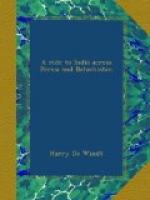The prospect, viewed from a warm and comfortable bed, was not inviting. Anxiety, however, to reach Teheran and definitely map out my route to India overcame everything, even the temptation to defer a journey fraught with cold, hunger, and privation, and take it easy for a few days, with plenty of food and drink, to say nothing of cigars, books, and newspapers, in the snug cosy rooms of the Consulate. “You will be sorry for it to-morrow,” said the colonel, as he left the room to give the necessary orders for our departure; adding with a smile, “I suppose a wilful man must have his way.”
There are two modes of travelling in Persia: marching with a caravan, a slow and tedious process; and riding post, or “chapar.” The latter, being the quickest, is usually adopted by Europeans, but can only be done on the Government post-roads, of which there are five: from Teheran to Resht, Tabriz, Meshed, Kerman, and the Persian Gulf port, Bushire. These so-called roads are, however, often mere caravan-tracks, sometimes totally hidden by drifting sand or snow. In the interior of the country the hard sun-baked soil is usually trackless, so that the aid of a “Shagird Chapar,” or post-boy, becomes essential.
The distance between the “Chapar khanehs,” as the tumble-down sheds doing duty for post-houses are called, is generally five farsakhs, or about twenty English miles; but the Persian farsakh is elastic, and we often rode more, at other times less, than we paid for. Travel is cheap: one keran per farsakh (2-1/2_d_. a mile) per horse, with a pour-boire of a couple of kerans to the “Shagird” at the end of the stage.
Given a good horse and fine weather, Persian travel would be delightful; but the former is, unfortunately, very rarely met with. Most of the post-horses have been sold for some vice which nothing but constant hard work will keep under. Kickers, rearers, jibbers, shyers, and stumblers are but too common, and falls of almost daily occurrence on a long journey. Goodness knows how many Gerome and I had between Resht and the Persian Gulf.
Notwithstanding these drawbacks, the speed attained by the wretched half-starved animals is little short of marvellous. Nothing seems to tire them. We averaged fifty miles a day after leaving Teheran, covering, on one occasion, over a hundred miles in a little over eleven hours. This is good work, considering the ponies seldom exceed fourteen hands two inches, and have to carry a couple of heavy saddle-bags in addition to their rider. Gerome must have ridden quite fourteen stone.
About ten o’clock the horses arrived, in charge of a miserable-looking Shagird, in rags and a huge lamb’s-wool cap, the only warm thing about him. It was pitiful to see the poor wretch, with bare legs and feet, shivering and shaking in the cutting wind and snow. The ponies, too, looked tucked up and leg-weary, as if they had just come off a long stage (which, indeed, they probably had) instead of going on one.




